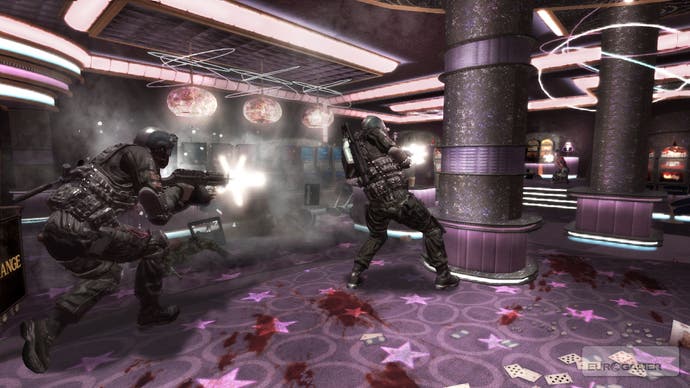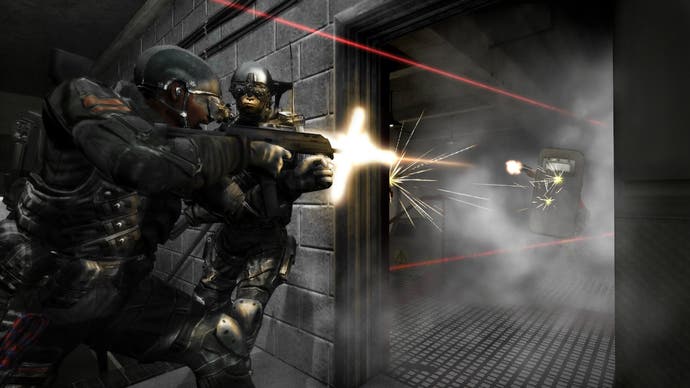Tom Clancy's Rainbow Six: Vegas 2
Hat-trick for violet.
There's a twisted little corner, somewhere in our tarnished souls, that harbours a smouldering and undying bitterness about the fact that Tom Clancy has his name splashed over so many fine games. For a man whose talent is the ability to recite mind-blowingly dull technical information about military equipment with all the narrative skill of a drunken Dan Brown telling bedtime stories to a sedated chimpanzee, having his name on Splinter Cell, Ghost Recon and Rainbow Six really isn't bad going. After all, when we try going off on ten-minute monologues about attack helicopters, our mates tell us to shut up. Perhaps Tom Clancy doesn't have very many mates.
Still, he can always console himself with the fact that rather a lot of people - Kristan included - really liked the last instalment in the Rainbow Six series, Rainbow Six: Vegas. It was a fantastic return to form after 2005's Rainbow Six: Lockdown, and a fine start on next-gen consoles. It's no surprise that Ubisoft decided that Rainbow Six was going to stay put for a little while after Vegas - with the Ubisoft Montreal team that created the original game now putting the finishing touches on Vegas 2.
Whoa, hold on - finishing touches? The original Rainbow Six: Vegas only poked its head above the parapet at the end of 2006, and they're already polishing off a sequel. What is this, Ubi Sports Covert Ops 2008?
Go Go Go

"No, it really wasn't rushed," designer Philippe Therien chuckles when we query the 15-month development cycle. "We looked at what we wanted to do and we budgeted the time according to it. We're on time, and happy with the result. The really key thing here is that the engine was solid and working - there's no point in spending more time developing new things that we don't need.
"We did put new features in - we've got sprinting, team orders for grenades, bullet penetration, the new ACES system... There's tons of new things in there, but we didn't really need anything fancy. We didn't, say, need to drive vehicles or stuff like that. That really wasn't necessary. That's why the entire development was spent just making new features, tweaking our graphics."
So, let's take a closer look at the new features that Ubisoft Montreal has added to Vegas, then. Sprinting, which gives you short bursts of speed, where you can't fire but are hard to hit, is certainly in there - a familiar concept, but a new addition to Rainbow Six. Bullets now penetrate different types of object differently, which introduces the idea of "visual cover" - thin screens that hide you from the enemy's view, but won't stop bullets from killing you stone dead.

AI has been tweaked significantly, too - not just for your enemies, but also for your team-mates. Send your squad off down a corridor and they won't stroll down like a bunch of pensioners out for a constitutional; they'll run from cover point to cover point, leapfrogging one another as they go so that one squad member is always ready to provide covering fire. They're also keenly aware of the bullet penetration we just mentioned, and won't hide behind cardboard except as a last resort.
Perhaps the most interesting of the new features - for players new to the series, especially - is the ACES system. At its simplest, this is Vegas' progression system. It's designed to track your achievements in various fields of gameplay, and reward you for them, keeping tabs on various feats related to Close-Quarters Battle (CQB), Assault, Marksmanship and other fields, and giving you access to new weapons and equipment related to those fields as you progress.
For instance, achieving good results in close-combat shooting might unlock a new shotgun for you; doing better in marksmanship will unlock a new sniper rifle. Things you unlock will be relevant to how you play the game - so not everyone will unlock the game's features in the same order.



